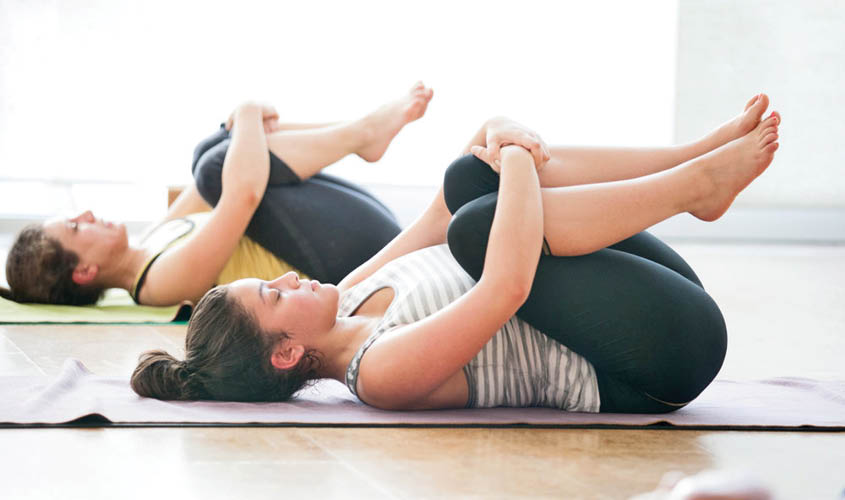The practice of yoga is believed to have started with the dawn of the Indus-Sarasvati civilisation in Northern India millennia ago, and also finds a mention in the Rig Veda. Over time, though, the general approach towards the discipline has changed significantly. “Modern yoga”, as one strain of the practice is now called, is gaining popularity the world over, as a means to enhance one’s beauty, strength and bodily flexibility. Presented here are five modern yoga styles that have found favour with practitioners young and old, both in India and overseas.
Yin Yoga
This is a slow-paced form of yoga. The poses in this style are held for at least five minutes or longer. The martial-arts expert and Taoist yoga teacher, Paulie Zink, founded and taught Yin Yoga in the United States in the late 1970s. The form belongs to the Taoist tradition, the religious and philosophical school of Chinese origin. Even though it progresses slowly over time, Yin Yoga presents its own challenges. Achieving perfection in its postures can be quite difficult due to the long holds, especially if your body is not acustomed to it. The purpose of this yoga style is to apply moderate stress to the connective tissues with an aim to increase blood circulation in the joints and to improve flexibility. The constant use of technology can cause mental stress, and Yin Yoga can provide an antidote to this. It is practiced when you are in a relaxed state, i.e. when you are either sitting or lying on the floor. There are no planks or core work involved in this style. Practicing Yin Yoga also affects our emotions positively and helps to keep them balanced.

Prenatal Yoga
Prenatal Yoga is uniquely designed for pregnant women. It can help support the moms-to-be, both emotionally and physically. Tara Stiles is the founder of this style, which, to say the least, is a revolutionary approach to healing through movement. Prenatal yoga can ease the discomforts, such as excessive mood swings, shortness of breath and swollen ankles, which are common during pregnancy. This form of yoga also gives the woman some time to bond with her baby, and can help them prepare for the rigours and mysteries of labour. Prenatal yoga classes also allow would-be-moms to interact with other pregnant women, so that they can learn from each other’s experiences. This form is all the more useful when a woman is feeling stressed, unsupported or fearful. It can help a woman become more resilient during and after pregnancy.

Restorative Yoga
Restorative Yoga is a gentle, relaxing and passive style. Held for five minutes or more, its restorative poses include light twists, seated-forward folds, and gentle back-bends. Most restorative yoga practices are based on the teachings of B.K.S. Iyengar, one of the foremost yoga teachers in the world and the founder of Iyengar yoga. In Restorative Yoga, props are used extensively to support the body, the betterbto hold the poses for longer periods of time. The postures in usually adapted from supine or seated yoga poses, which with the use of blocks, bolsters, and blankets eliminate the unnecessary straining. Restorative Yoga is extremely beneficial for people who have a hectic life. It helps you to connect with your mind and body, and lets you focus on your breathing. It consists of five to six poses that allow you to rest and relax on a given prop. It is among the most meditative forms of yoga in the world.

Power Yoga
Power Yoga is a vigorous style. The term itself, Power Yoga, came into being in the 1990s. Two Americans, Beryl Bender Birch and Bryan Kest–who studied with K. Pattabhi Jois, the Indian yoga teacher who popularised the vinyāsa style of yoga–are credited with its invention. It is also known as “gym yoga”, for the reason that it brought yoga into the gyms as people began to see it as a legitimate way to work out. In Power Yoga, you move in and out of poses quickly, lifting and holding your entire body weight while you are at it. It is an offshoot of Ashtanga Yoga, a form that is practiced for core strength and toning the body. There are several similiarities between Power Yoga and Ashtanga Yoga, both help built internal strength, stamina, and flexibility, as well as aid in stress reduction. Power Yoga is stimulating, energising and at the same time relaxing for the body.

Hot Yoga
Hot Yoga comprises specific yoga poses that are practiced in a heated room. The high temperature helps prepare the body for movement. It is a vigorous form of yoga, which is performed under the temperature of 105 degrees farenheit and 40% humidity. The high level of heat leads to profuse sweating. The formal name for hot yoga is “Bikram Yoga”. Founder Bikram Choudhury started it in 1972 in San Francisco. A typical Hot Yoga class is a 90-minute session that consists of a series of 26 postures. The postures require lengthy, forceful and well-controlled contractions of all major muscle groups. The demanding nature of the poses and the high temperatures under which the style is performed raises the heart rate and pumps the muscles. Hot Yoga is detoxifying and helps in weight loss as well.

